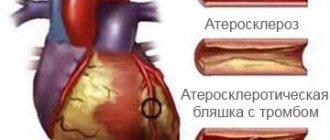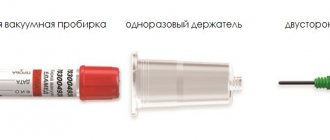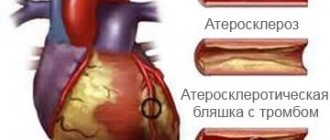A reminder for the patient about the rules for donating blood
Blood is a mirror image of your health. A blood test is an important tool that characterizes your condition. It is used to assess the pathological condition, monitor treatment, as well as during screening and preventive examinations. The simplest informative blood test is a clinical analysis.
These studies include:
- A general blood test (leukocytes, erythrocytes, platelets, leukocyte formula, ESR, reticulocytes) is prescribed for screening and dispensary examinations, when monitoring ongoing therapy, differential diagnosis of blood, and when diagnosing hematological, infectious, and inflammatory diseases.
- Biochemical blood test - aimed at determining the level of glucose, proteins, disorders of fat (lipid) metabolism, enzymes, inorganic substances, including microelements. This analysis makes it possible to identify abnormalities in the functioning of the liver, kidneys, cardiovascular system, diagnose anemia, and in the differential diagnosis of oncological diseases.
- A blood test for allergens is part of a group of immunological studies that provide insight into the state of the immune system as a whole (cellular and humoral immunity). The main goal of diagnosis for allergic diseases is to determine the allergen or allergens to which the patient is hypersensitive.
- A blood test for hormones will help identify hormonal changes that may be the result of dysfunction of the thyroid, pancreas and gonads, and also allows you to determine the dysfunction of fat metabolism and assess the condition of the gastrointestinal tract.
A blood test will help in diagnosing infectious diseases (viral, bacterial, fungal, parasitic). When providing diagnostic assistance, laboratory analysis is the safest, most accessible and provides objective information about the patient’s condition. For most studies, the biomaterial is blood. There are a number of rules that must be followed before taking a blood test. Compliance with the recommendations will allow you to obtain accurate and reliable information about the patient’s condition.
The main factors influencing the result of a blood test:
- taking medications
- meal
- physical and emotional overload
- drinking alcohol
- smoking
- physiotherapy
- instrumental examinations (X-ray, CT, MRI, etc.)
- phase of the menstrual cycle in women
- time of day when blood is drawn
General rules when donating blood for analysis:
- if possible, donate blood for analysis in the morning, between 8 and 11 o’clock, on an empty stomach (at least 8 hours and no more than 14 hours of fasting, drink water, as usual), avoid food overload the day before;
- if you are taking medications, you should consult with your doctor about the advisability of conducting a laboratory test while taking the drug or the possibility of stopping the drug before taking a blood test;
- alcohol – avoid drinking alcohol on the eve of the study;
- Smoking – do not smoke for at least 1 hour before the test;
- exclude physical and emotional stress on the eve of the study;
- before taking the test, rest for 10-20 minutes;
- It is not advisable to take the test after any medical procedures (physiotherapeutic, ultrasound, etc.);
- When monitoring laboratory tests over time, it is recommended to conduct repeated tests under the same conditions - in the same laboratory, donate blood at the same time of day, etc.
Special dietary requirements:
- strictly on an empty stomach, after 12-14 hours of fasting, you should donate blood for analysis to determine lipids (cholesterol, HDL, LDL, triglycerides, apoA1, apoB, VLDL, liporoprotein A)
- The glucose tolerance test is performed in the morning on an empty stomach (after at least 12, but not more than 16 hours of fasting).
Taking blood
For blood collection, only vacuum systems are used to eliminate the possibility of errors and the biological safety of the patient. Blood collection for analysis is carried out by highly qualified specialists. The studies are performed on automatic analyzers, which ensures high reproducibility and quality of results. The deadline for scheduled analysis is within a day, urgent – cito! – within 2 hours.
Why is it better to donate blood from a vein rather than from a finger?
5 reasons to donate blood from a vein, and not from a finger: 1. When taken from a finger, some of the red blood cells are destroyed, microclots can form in the test tubes, which make it difficult to conduct a blood test. In order to avoid repeated testing, it is recommended to donate blood from a vein; 2. to draw blood from a vein, disposable safe VACUETTE systems are used, which exclude infection and meet all international standards; 3. in laboratory studies, it is the composition of blood from a vein, and not from a finger, that allows us to make the most accurate conclusion, timely identify and prevent the disease; 4. the procedure for taking blood from a vein takes a matter of seconds, is absolutely safe and painless even for small children; 5. Blood is taken from a vein by nurses who have many years of experience working with veins of any complexity.
- Back
- Forward
Manipulations at the preanalytical stage of laboratory research are the main source of errors and incorrect results. According to the literature, errors at the preanalytical stage are the cause of more than 60% of unreliable results. At the actual analytical stage of the study, according to the same data, no more than 20% of errors are introduced; Moreover, some of them are also due to previous disorders at the preanalytical stage (Fig. 1).
Figure 1. Number of errors identified at all stages of laboratory research, in %. M. Plebani and P. Carraro. 1348-1351 (1997).
The preanalytical stage begins much earlier than is usually described in textbooks. It must be remembered that any treatment process includes not only an assessment of the diagnostic value of the test, but also the need to prescribe monitoring, accompanying and additional procedures and studies. Therefore, the purpose of the study and the preparation of the patient for the collection of biomaterial should also be considered as components of the preanalytical stage.
Collection of biomaterial, transportation, storage and sample preparation are divided into non-laboratory and laboratory parts. The main task of these stages is to ensure the stability (safety) of the obtained biomaterials and minimize the influence of various factors that change their quality.
Proper preanalytical preparation is one of the main conditions for accurate laboratory diagnostics.
Currently, most clinics use a vacuum method of collecting venous blood. This method is as convenient as possible for both the patient and medical staff.
(Austria) is one of the leading manufacturers of vacuum systems for collecting biomaterial. Such systems ensure maximum safety for a medical worker when taking venous blood due to the fact that contact of blood with the environment is completely eliminated. However, even with good experience working with such systems, problems can sometimes arise.
Modern requirements for obtaining biomaterial are described in detail in the National Standards, however, in fulfilling these requirements, medical personnel often encounter a number of difficulties:
1. Blood does not flow into the test tube.
There may be several reasons for this, and each of them has its own solution:
2. During venipuncture, the blood flow suddenly stops quickly without filling the tube.
In this case, medical personnel should pay attention to the following possible causes and know how to solve the problem:
3. Hemolysis in vitro.
Hemolysis (damage to red blood cells during blood collection) is the process of damage to red blood cells in which hemoglobin is released from them into the environment. Blood or a suspension of red blood cells turns into a clear red liquid (“lacquered blood”). Hemolysis may render the sample unsuitable for analysis. The main causes and solutions to problems are as follows:
Let us dwell in more detail on the procedure for “direct” transfer of blood from a syringe into a vacuum tube, when the stopper is pierced with a syringe needle and the blood is forcefully squeezed out with a piston. This procedure has a number of disadvantages:
1. Sample transfer occurs under excess pressure, which leads to blood foaming, hemolysis and protein denaturation.
Denaturation of proteins:
— distorts the results associated with determining the activity and concentration of all proteins and enzymes, the activity of which directly depends on the spherical configuration of the protein molecule;
— leads to an increase in sample turbidity, which distorts the results of photometric techniques;
hemolysis is the main reason for the laboratory’s refusal to accept a sample for testing. Any hemolytic test is considered obviously incorrect.
2. Transferring a blood sample into a test tube with reagents necessitates precise dosing; when squeezing out blood with a piston, the test tube often overflows.
3. Handling an open needle carries the risk of injury to personnel from a contaminated needle.
Using a special holder to safely transfer blood from the syringe to the tube avoids these problems.
The syringe-to-tube blood transfer holder from the VACUETTE product line is designed for the correct transfer of blood samples from syringes. The design of the holder eliminates the risk of injury to medical personnel and facilitates blood transfer without additional manipulation. The holder complies with CLSI (Clinical and Laboratory Standards Institute) guidelines H3-A5. Follow these steps: draw a blood sample into a syringe using the procedure accepted in your medical institution (Fig. 2, a),
Figure 2. Holder for transferring blood from a syringe to a VACUETTE tube (a).
Explanation in the text. insert the test tube into the holder to transfer blood from the syringe to the test tube and press so that the holder needle pierces the stopper (Fig. 2, b),
Figure 2. Holder for transferring blood from a syringe to a VACUETTE tube (b).
Explanation in the text. as soon as the sample stops flowing into the test tube, carefully remove the test tube from the holder, continuing to hold it with your other hand (Fig. 2, c).
Figure 2. Holder for transferring blood from a syringe to a VACUETTE tube (c). Explanation in the text.
In addition, when studying a number of indicators, other errors are possible due to failure to comply with special requirements for the preanalytical process for this parameter.
1. Specific time of blood collection. In some cases, blood must be drawn at certain times: when taking certain medications, on an empty stomach and/or due to daily fluctuations in biological parameters (circadian rhythm). It is important that such samples are taken within a strictly specified period of time. The necessary instructions should be given to personnel performing venipuncture to ensure that these rules are strictly followed.
Examples of studies that require blood sampling at a certain period of time:
- studies of indicators that change during the day (for example, glucose, corticosteroids and other hormones, serum iron);
- monitoring of therapy (for example, prothrombin time, aPTT, concentration of salicylic acid, digoxin and other drugs).
In many of these situations, it is necessary to accurately record the dose of the drug and the time you last took it, as well as the time of the blood draw, on the referral form.
2. Features of blood collection for individual studies:
— determination of blood alcohol content. When taking a sample to determine blood alcohol content, disinfection of the venipuncture site should be carried out with an alcohol-free substance (for example, soap);
— samples for blood culture. When collecting, transporting and storing samples for blood culture, certain time and temperature conditions must be observed. In addition, there are differences in the volume of blood required for culture. Typically, one test requires taking 10-20 ml of blood from an adult and 1-2 ml of blood from a newborn;
- microelements. The VACUETTE product line includes special tubes for determining the concentration of trace elements.
3. Features of taking blood using catheters. There are a number of systems, the quality of which is of great importance when conducting laboratory diagnostics for patients in emergency clinics. This primarily concerns catheters and fistulas.
Possible mistakes
Indwelling catheters are usually placed in critically ill patients receiving massive fluid resuscitation. Taking blood samples from indwelling catheters may result in erroneous test results due to incomplete flushing of the entire length of the catheter. This results in contamination of the sample with drugs and/or dilution of the blood sample (Fig. 3).
Figure 3. Features of blood collection using catheters. The HOLDEX disposable holder is designed for use with VACUETTE butterfly needles, Luer needles or catheters.
Flushing catheters
Before collecting a sample, sufficient blood should be removed from the catheter to ensure that the sample is not diluted or contaminated. The volume of blood removed depends on the internal volume of the particular catheter. To study the hemostasis system, it is recommended to drain blood in an amount of at least 6 catheter volumes (5-7 ml), for other studies - at least 2 ml.
If a butterfly needle with a metal siliconized needle is installed in a patient in an emergency during emergency treatment for intravenous administration of drugs or for drawing blood, then it can be left in the vein for a period of 36 to 48 hours. Butterfly needles of the VACUETTE system (Austria) are intended for taking venous blood from children and patients with hard-to-reach veins for quick and painless venipuncture. The VACUETTE product line for venous blood collection includes both standard butterfly needles and SAFETY butterfly needles with a needle stick protection mechanism (Fig. 4).
Figure 4. Butterfly needles of the VACUETTE system (Austria) for the VACUETTE vacuum blood collection system.
Infusion therapy
If a patient is receiving intravenous fluids, blood should not be drawn from the same arm if possible. Blood collected proximal to the intravenous infusion site has been shown to be diluted with the injected solution. In addition, the solution may contain the analyte of interest. The results of the blood test in this case will be erroneous. It is necessary to find a place to draw blood on the other arm. Sometimes intravenous infusion can be given in both arms.
Satisfactory samples can be obtained by drawing blood distal to the intravenous infusion site. To do this, the following is recommended:
- turn off the IV at least 2 minutes before venipuncture;
— apply a tourniquet distal to the infusion site;
- choose a vein into which infusion is not carried out;
- perform venipuncture.
The referral form must indicate that the specimen was taken from the arm receiving the IV infusion.
If veins are not available, capillary blood collection is recommended.
Due to the possible occurrence of errors during research, taking blood from the intravenous infusion site should be avoided during the first 2 days after its discontinuation (Fig. 5).
Figure 5. Preparing the vein for infusion therapy.
In conclusion, it should be noted that in this article we have considered only some of the issues affecting the preanalytical stage. Problems associated with the preanalytical stage of laboratory research cannot be solved by one employee and require joint action by doctors, nurses and other laboratory personnel involved in the workflow of the medical institution. We hope that the errors discussed above that arise when working with vacuum tubes, and methods for solving them, as well as the peculiarities of taking venous blood, will allow readers to make a correct assessment and improve the quality of research.









